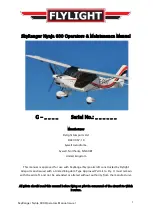
Flight manual DG-800S
3.8
Flight with asymmetric waterballast
If you suspect that the waterballast does not dump symmetrically you
have to close the dump valves of the wingtanks immediately, to avoid
greater asymmetry.
Asymmetry can be verified by the necessary aileron deflection in straight
flight at low airspeeds.
When flying with asymmetric waterballast you have to increase the
airspeed, especially in turns, so that you can avoid a stall at all costs.
If the aircraft does enter a spin though, you have to push the stick forward
clearly during recovery.
Fly the landing pattern and touch down appr. 10 km/h (6 kts.) faster than
usually and after touch down control carefully the bank angle to avoid the
wing touching the ground too early.
3.9
Emergency wheel up landing
It is not recommended to execute a wheel up emergency landing, as the
energy absorption capability of the fuselage is much smaller than that of
the landing gear. If the landing gear can't be extended use wing flap
setting L and touch down with small angle of attack.
3.10
Emergency ground loop
If there is the risk of overshooting the landing strip you have to decide at
least 40 m (130 ft) before the end of the field to execute a controlled
ground loop. If possible turn into the wind, lift the tail by pushing the
stick forward.
3.11
Emergency landing on water
From the experience with emergency water landing we know, that it is
likely that the sailplane will dive into the water, cockpit first.
Therefore an emergency landing on water should be the last choice.
In the case of a water landing, however, extend the landing gear.
Issued: April 1997
App. 3.4
















































